The houseplant trade is currently booming with new plant aficionados discovering their love of plants every day. And it’s no wonder. Houseplants add beauty and elegance to any home and have so many other benefits too.
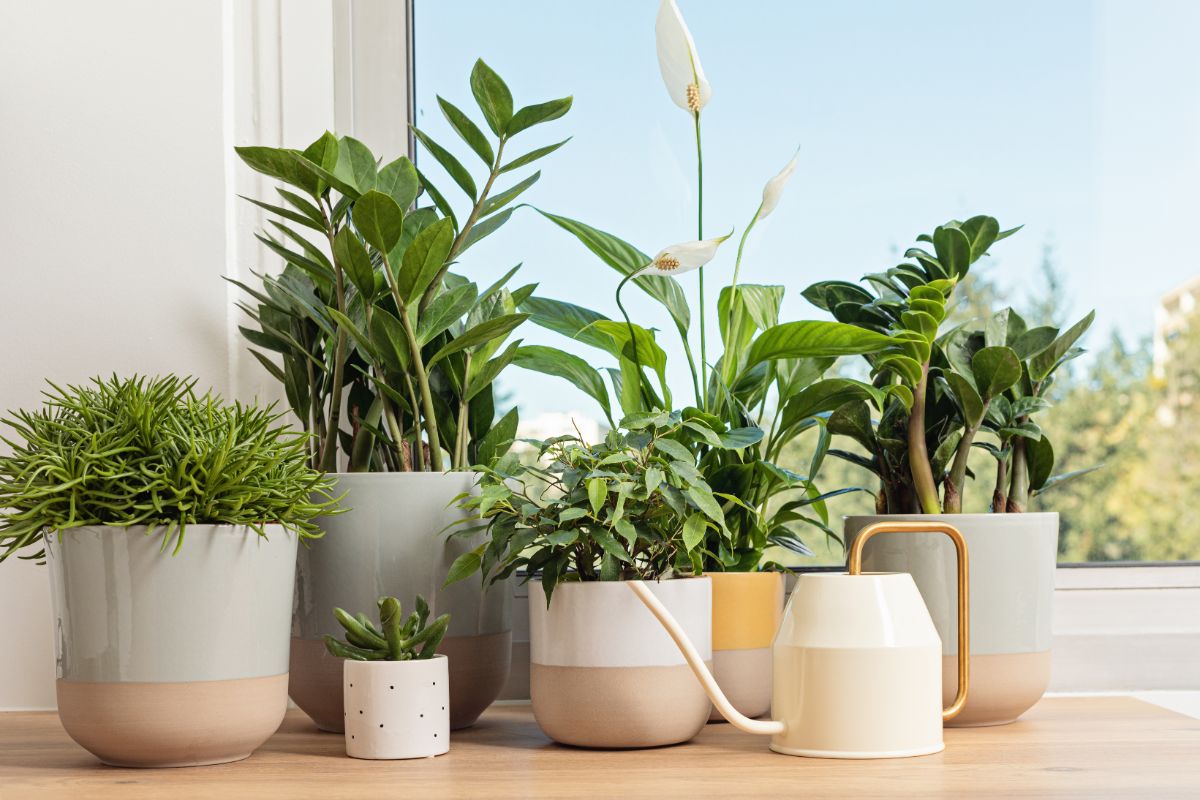
But if you’re new to houseplants and are looking for inspiration for the best plants to try in your home, look no further. This guide includes some of the most popular indoor plants around. From succulents to tropicals, this list includes something for everyone.
Jump to:
- Top 25 popular houseplants growers love
- 1. Snake plant (Dracaena trifasciata)
- 2. Pothos (Epipremnum aureum)
- 3. ZZ plant (Zamioculcas zamiifolia)
- 4. Spider plant (Chlorophytum comosum)
- 5. Lucky bamboo (Dracaena sanderiana)
- 6. Cast iron plant (Aspidistra elatior)
- 7. Staghorn fern (Platycerium bifurcatum)
- 8. Peace lily (Spathiphyllum wallisii)
- 9. Philodendron (Philodendron spp.)
- 10. English ivy (Hedera helix)
- 11. Dieffenbachia (Dieffenbachia spp.)
- 12. Friendship plant (Pilea involucrata)
- 13. Monstera (Monstera deliciosa)
- 14. Arrowhead plant (Syngonium podophyllum)
- 15. Grape ivy (Cissus rhombifolia)
- 16. Bird’s nest fern (Asplenium nidus)
- 17. Oyster plant (Tradescantia spathacea)
- 18. Prayer plant (Maranta leuconeura)
- 19. Jade plant (Crassula ovata)
- 20. Rattlesnake plant (Goeppertia insignis)
- 21. Purple passion plant (Gynura aurantiaca)
- 22. Fiddleleaf fig (Ficus lyrata)
- 23. Money plant (Pilea peperomioides)
- 24. Rubber plant (Ficus elastica)
- 25. African violet (Saintpaulia ionantha)
- Frequently asked questions
- Summary
Top 25 popular houseplants growers love
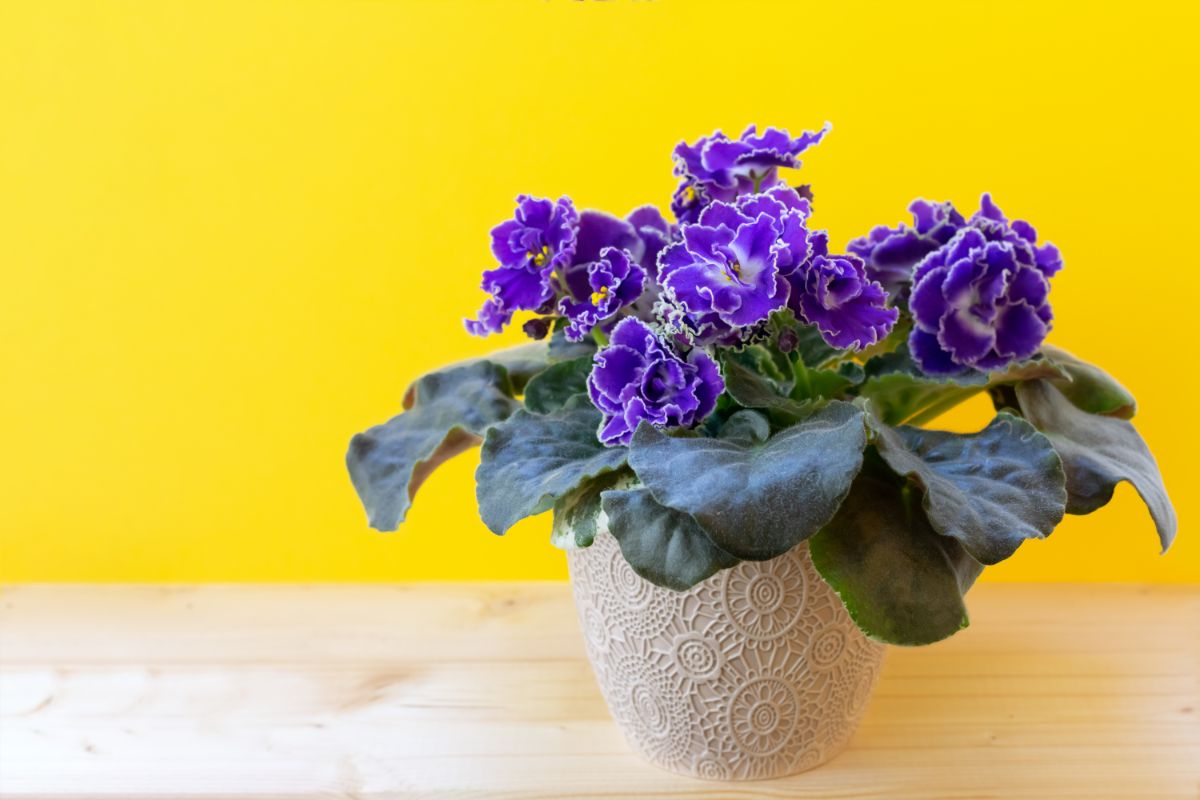
In the following list, we’ve included some of plant keepers’ favorite houseplants. Our selections include many different plant types, sizes and colors, with other special features like beautiful blooms and interesting textures. No matter your interest level, you’re sure to find the perfect plant for you on this list.
1. Snake plant (Dracaena trifasciata)
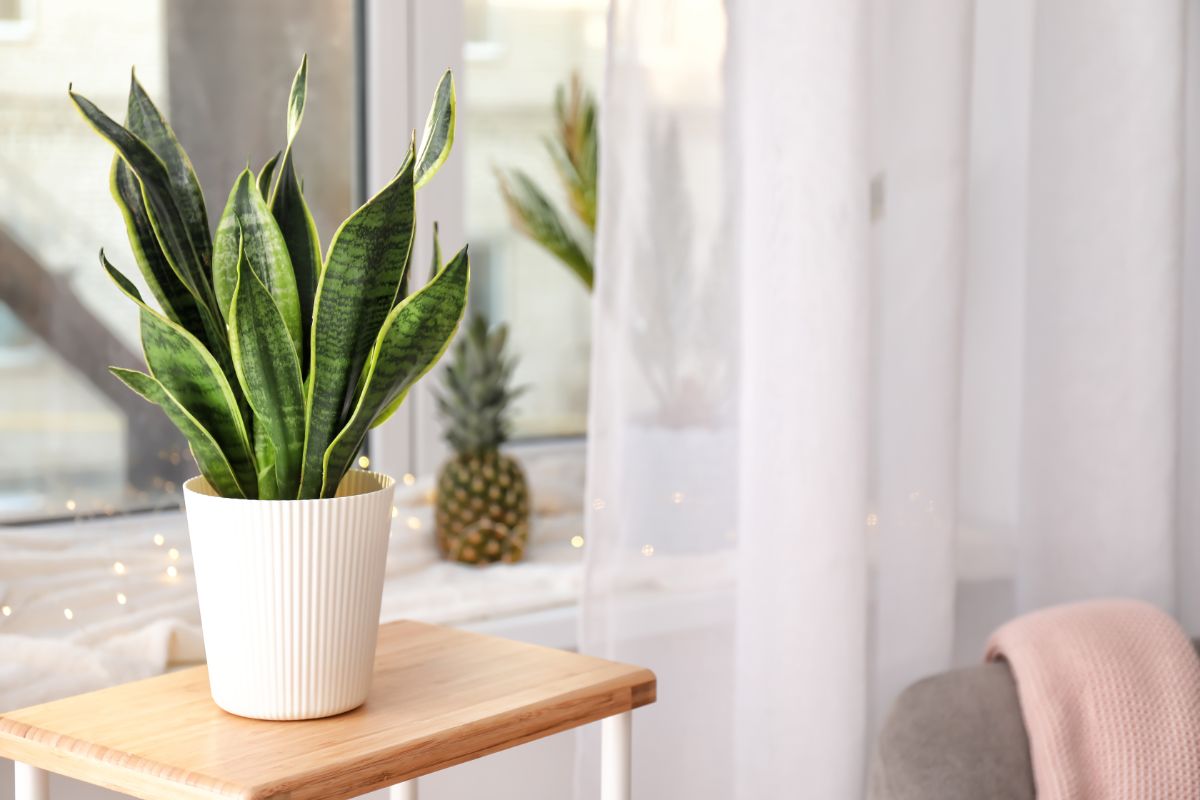
| Plant name: | Snake plant |
| Watering requirements: | Low |
| Toxic to pets? | Yes |
| Size: | 6” to 8’ high, depending on variety |
| Special features: | Ultra-hardy plant; great for beginners |
One of the most resilient plants around, there’s so many reasons to love snake plants. These hardy plants require very little care, minimal watering and can adapt to very low light if you live in a shady home. These also come in many different varieties with highly variegated leaves that occasionally have yellow coloration at leaf margins.
Snake plants are also nicknamed “mother-in-law tongues” for their spiky, upright, blade-shaped leaves. But, if you’re looking for something different, try out cylindrical snake plants, which look a bit like a starfish.
2. Pothos (Epipremnum aureum)
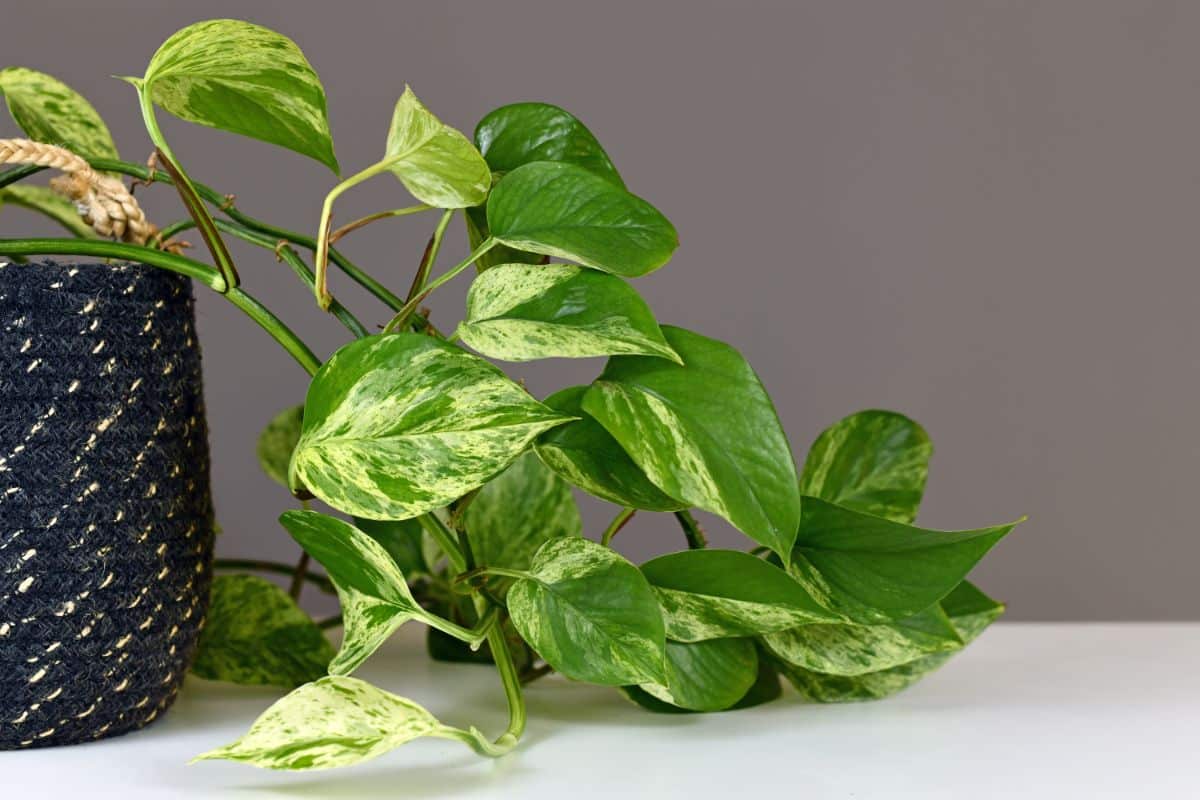
| Plant name: | Pothos |
| Watering requirements: | Moderate |
| Toxic to pets? | Yes |
| Size: | 6 to 10’ long vines when grown indoors |
| Special features: | Very easy to propagate; can be grown in water; great for hanging baskets |
It’s hard to find a houseplant collection without at least one pothos. These easy-to-find houseplants are also very low maintenance, so they are great for beginning gardeners. Heart-shaped leaves come in a range of colors and variegation patterns, while the vining growth habit is perfect for hanging planters.
Another plant that is well-adapted to lower light homes, pothos is one of the few plants that can grow quite happily in water or soil. That makes it a great choice for semi-aquatic aquariums or ripariums. Pothos also comes in many varieties, such as ‘Marble Queen’ and ‘Neon’ pothos, and many houseplant owners love collecting them all!
3. ZZ plant (Zamioculcas zamiifolia)
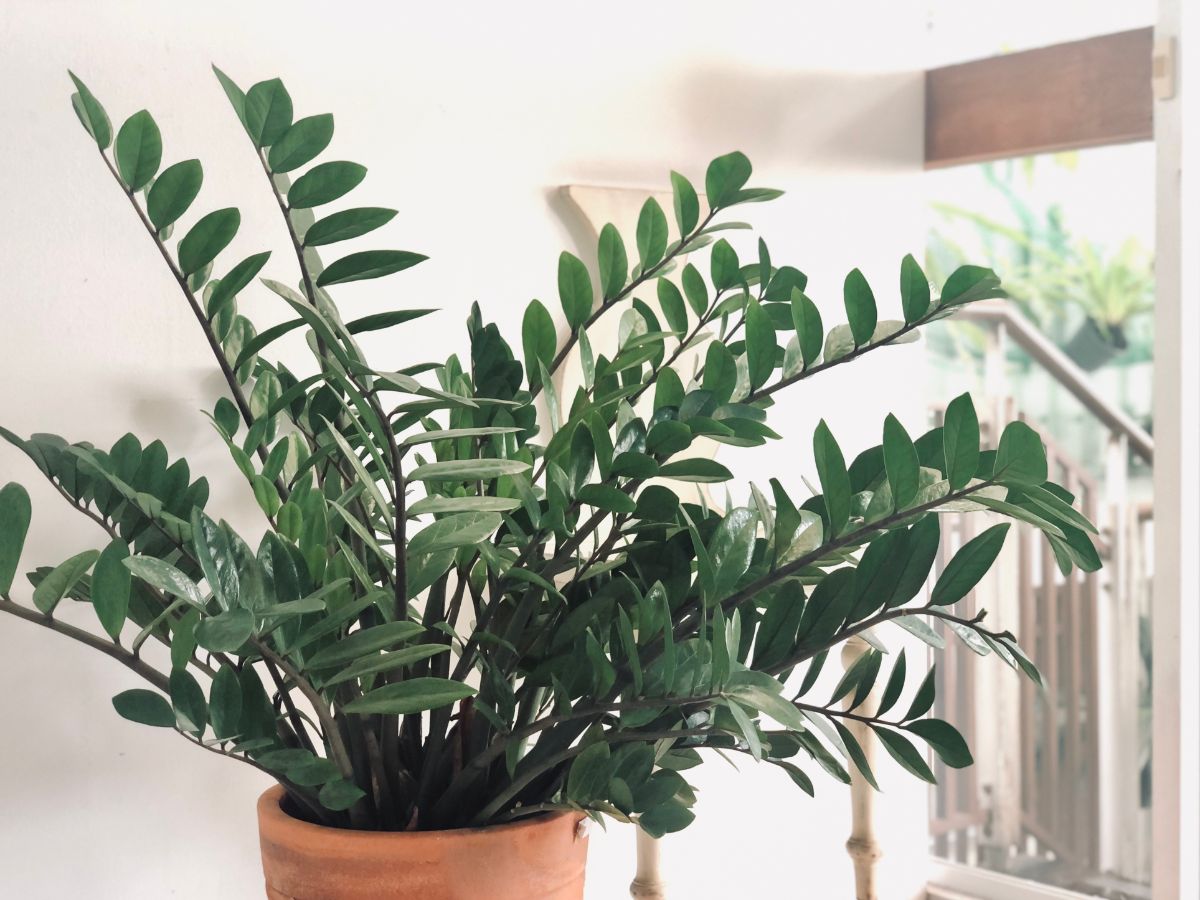
| Plant name: | ZZ plant |
| Watering requirements: | Low |
| Toxic to pets? | Yes |
| Size: | 3 to 4’ high |
| Special features: | Ultra-hardy plant; great for beginners |
Stately ZZ plant has fine, sweeping stems embellished with glossy ovate leaves. This plant comes in either a rich, green hue or a highly coveted dark variety known as ‘Raven ZZ.’ Nearly indestructible specimens, ZZ plants require very little watering and can adapt to minimal light.
Easily propagated via underground rhizomes, ZZ plants should be divided approximately once every 2 to 3 years to keep them from getting overgrown. Very rarely, these plants will also bloom a creamy-toned, cylindrical flower at the base of the plant’s stems.
4. Spider plant (Chlorophytum comosum)

| Plant name: | Spider plant |
| Watering requirements: | Moderate |
| Toxic to pets? | No |
| Size: | 12 to 15” high |
| Special features: | Very easy to propagate |
A classic, crowd favorite, spider plant features delicately arching, grass-like leaves that come in either solid green or variegated colorings. Overall, these plants are quite hardy and are good for beginning gardeners. However, their leaves can be easily damaged or bruised by rough handling, so they are often safest when kept out of the way in a hanging basket.
Adaptable to a range of lighting conditions, spider plants are easy to propagate in either soil or water.
5. Lucky bamboo (Dracaena sanderiana)
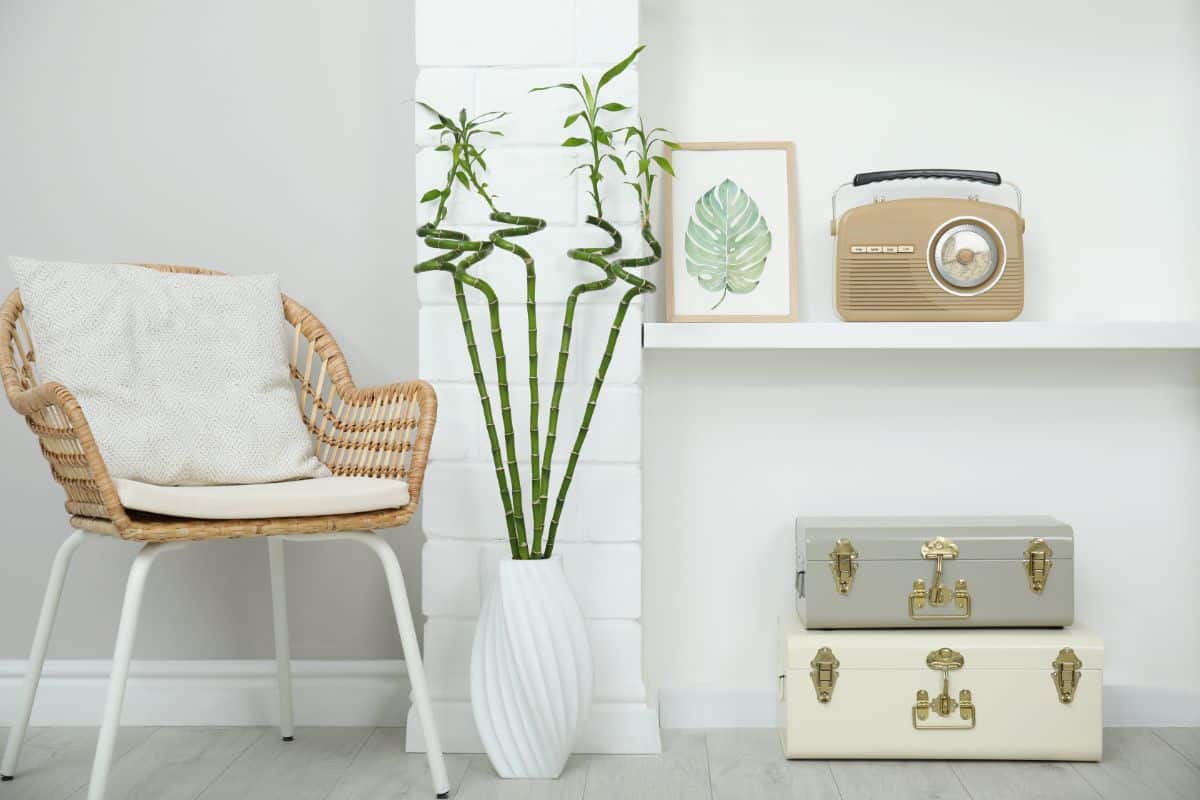
| Plant name: | Lucky bamboo |
| Watering requirements: | Moderate |
| Toxic to pets? | Yes |
| Size: | 1 to 5’ high |
| Special features: | Can be grown in soil or water |
Despite its name, lucky bamboo isn’t bamboo at all, but is a type of dracaena, like corn plant or the dragon tree. Bright green, grass-like leaves extend from segmented, woody stems, which come in either straight or curled options for lots of visual interest.
Lucky bamboo is often sold in water and can grow this way for a while. But for healthier plants, try potting up your lucky bamboo in a small pot with a rich, well-draining soil.
6. Cast iron plant (Aspidistra elatior)
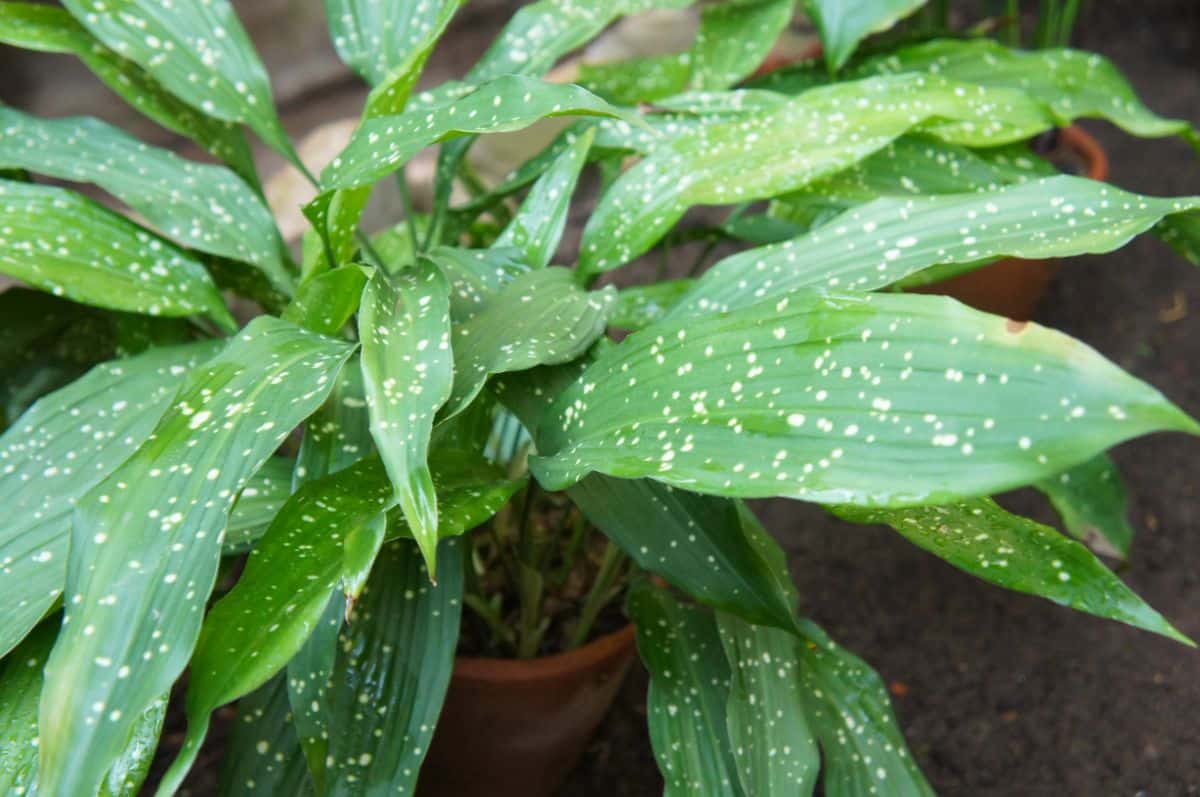
| Plant name: | Cast iron plant |
| Watering requirements: | Moderate to low |
| Toxic to pets? | No |
| Size: | 2’ high |
| Special features: | Ultra-hardy plant; great for beginners |
Named for its hardy nature, the cast iron plant is native to Taiwan and Japan and was first introduced to Europe in the 1820s. A slow-growing evergreen plant, this adaptable species was quick to become popular due to its ability to thrive in adverse conditions, including the poorly lit homes of the 19th century.
While it’s not the showiest of plants, it has fine lines and gently draping, lance-shaped leaves that add a perfect touch of color to any interior.
7. Staghorn fern (Platycerium bifurcatum)
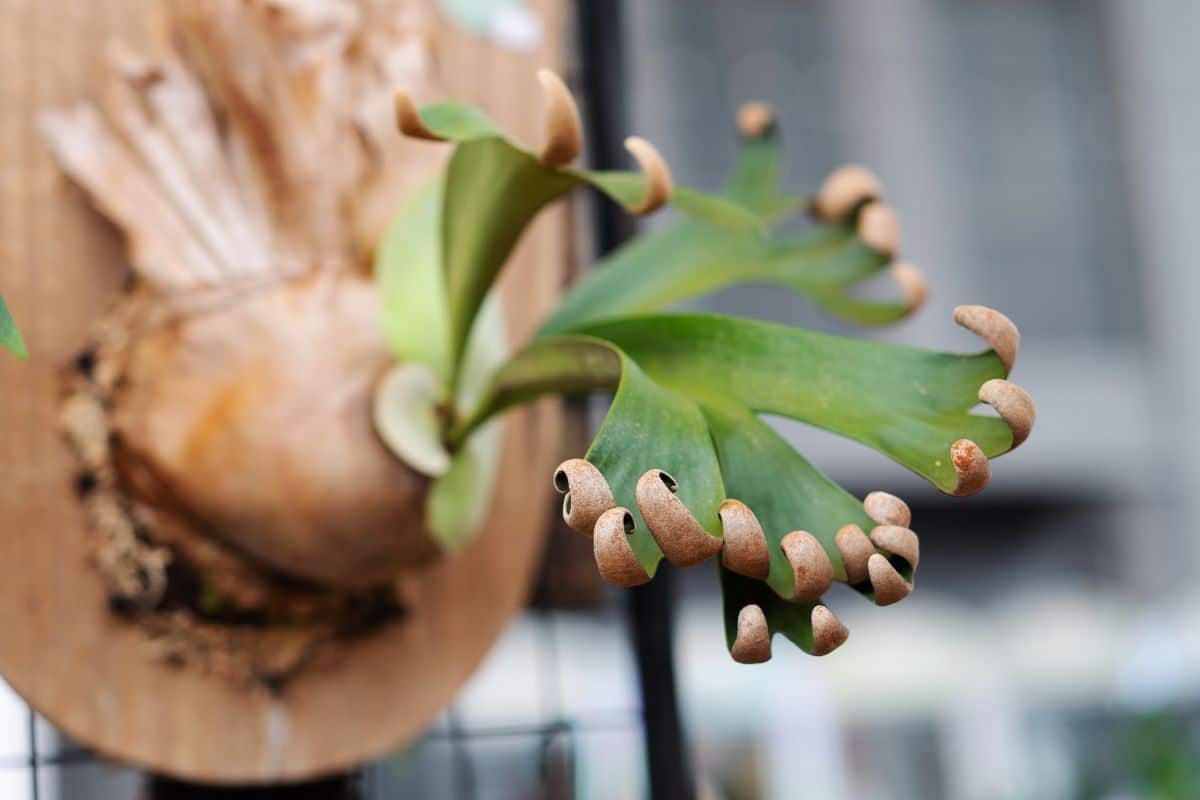
| Plant name: | Staghorn fern |
| Watering requirements: | Moderate to low; benefit from extra humidity |
| Toxic to pets? | No |
| Size: | 3’ wide |
| Special features: | Great for wall mounting |
Staghorn ferns feature lightly fuzzy, pale green leaves that are highly lobed like the antlers of a stag. Epiphytes in nature, these plants naturally grow on trees, and many homeowners choose to mount them on a section of driftwood or wooden plaque for an interesting look.
Like other ferns, staghorn ferns require higher than average indoor humidity levels, so be prepared to mist them regularly or add a humidifier nearby. If you’re interested in mounting your staghorn on wood, many crafters choose to do so with a bit of clear fishing line concealed with some sphagnum moss to create nice, clean lines.
8. Peace lily (Spathiphyllum wallisii)
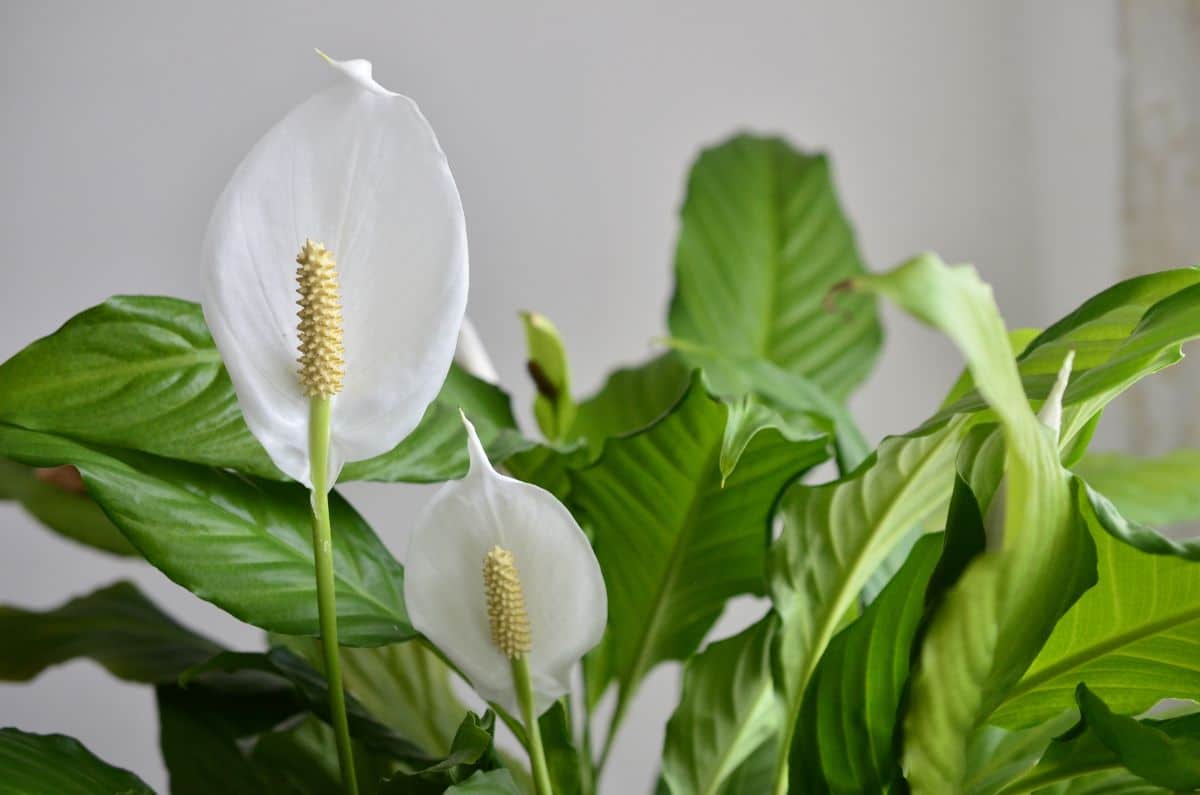
| Plant name: | Peace lily |
| Watering requirements: | High |
| Toxic to pets? | Yes |
| Size: | 1 to 4’ high |
| Special features: | Produces flowers |
Similar in appearance to the cast iron plant, peace lilies have one added bonus: they bloom reliably. Peace lily flowers are white to cream in tone and usually appear in spring. Just keep in mind that these plants require regular moisture and will dramatically wilt if their soil is allowed to dry out.
Although peace lilies don’t like dry soil, they are otherwise quite hardy plants that are beginner friendly. However, like other lilies, they should be avoided in homes with cats, as they are highly toxic to felines.
9. Philodendron (Philodendron spp.)
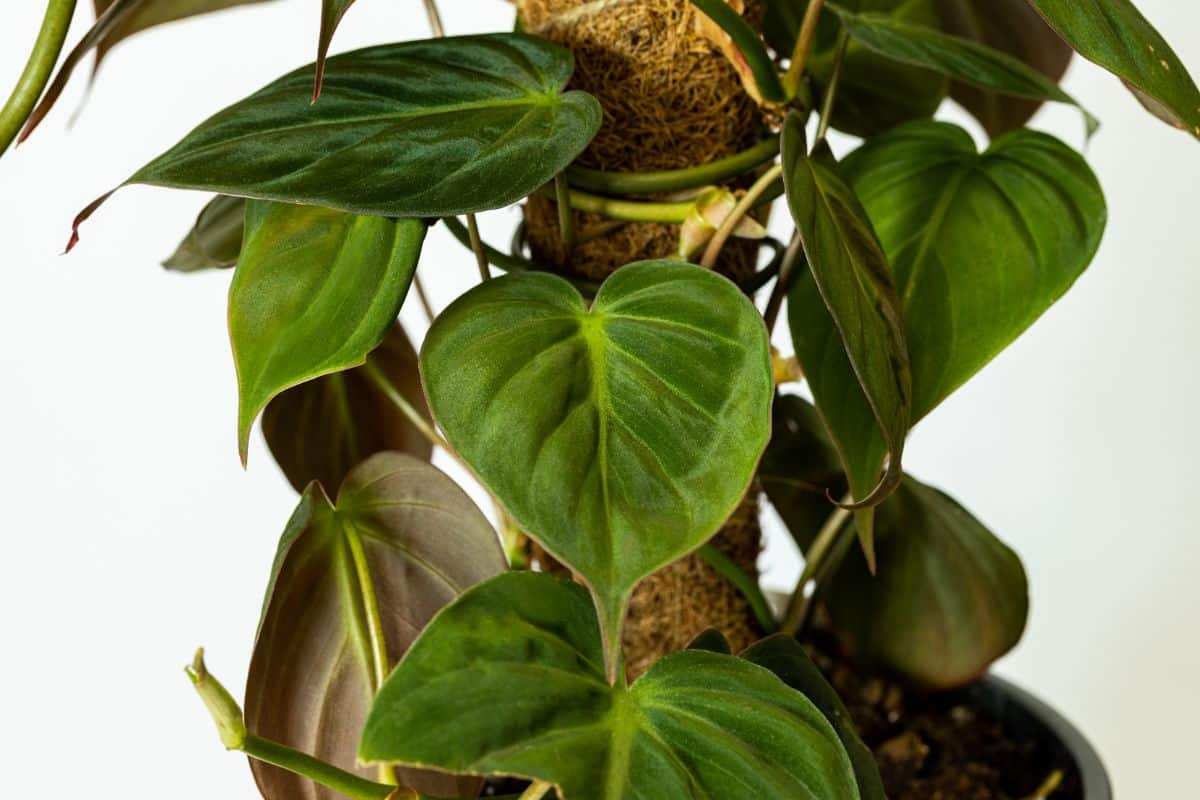
| Plant name: | Philodendron |
| Watering requirements: | Moderate |
| Toxic to pets? | Yes |
| Size: | 4’ long vines when grown indoors |
| Special features: | Very easy to propagate; great for hanging baskets |
There are many different types of philodendrons to choose from, including some with upright growth habits that work perfectly as tabletop or floor plants. But some of the most collected philodendrons around are vining plants that look absolutely stunning in hanging baskets.
From velvet leaf philodendron to heartleaf philodendron, these attractive plants look similar to pothos, with heart-shaped leaves and trailing stems. For a fuller plant look, try planting several rooted stems in a single pot together.
10. English ivy (Hedera helix)
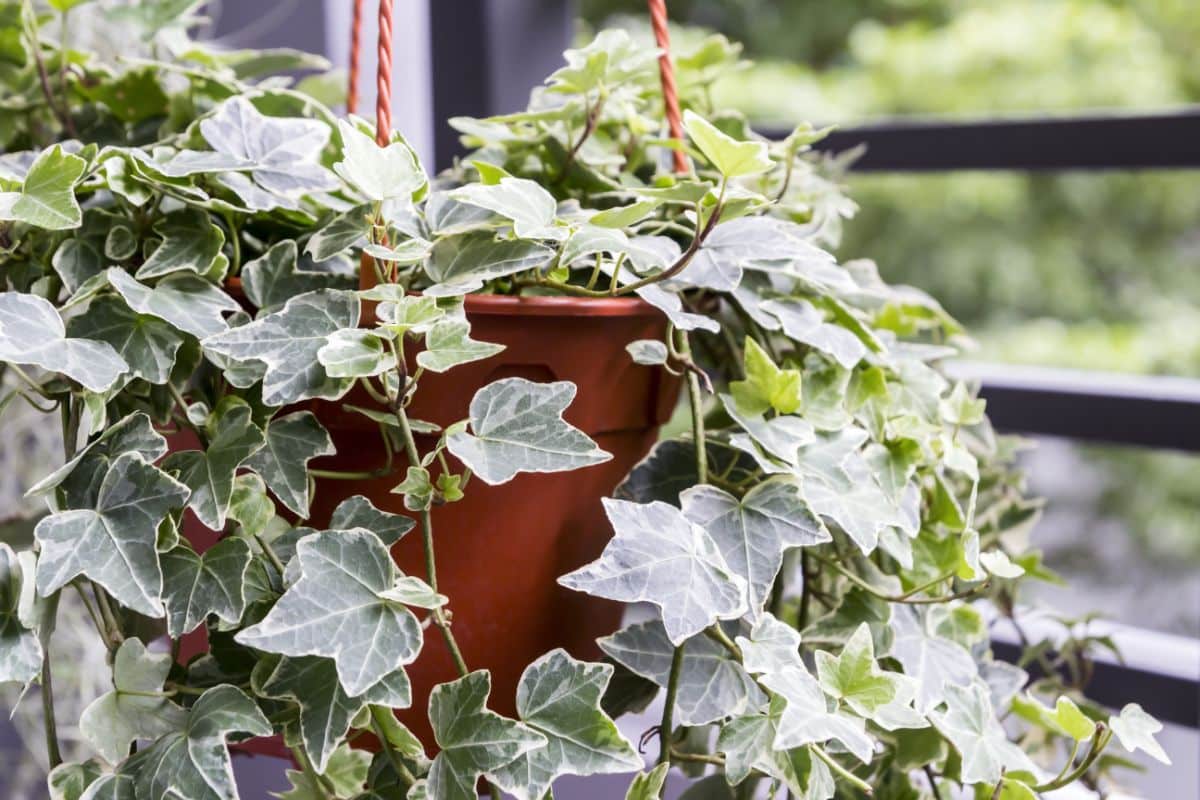
| Plant name: | English ivy |
| Watering requirements: | Moderate |
| Toxic to pets? | Yes |
| Size: | Up to 9’ long vines when grown indoors |
| Special features: | Great for hanging baskets or terrariums |
Commonly grown as an outdoor plant, English ivy can become invasive quickly in the wild. However, it is a much more easily managed houseplant. That said, if you choose to keep this plant indoors, take care with its roots as they can damage walls and masonry.
For tidier plants, English ivy do quite well in terrariums. Just keep your plants well-pruned to prevent them from outgrowing their enclosure. And, for a special treat, try out variegated ivies for even more color.
11. Dieffenbachia (Dieffenbachia spp.)
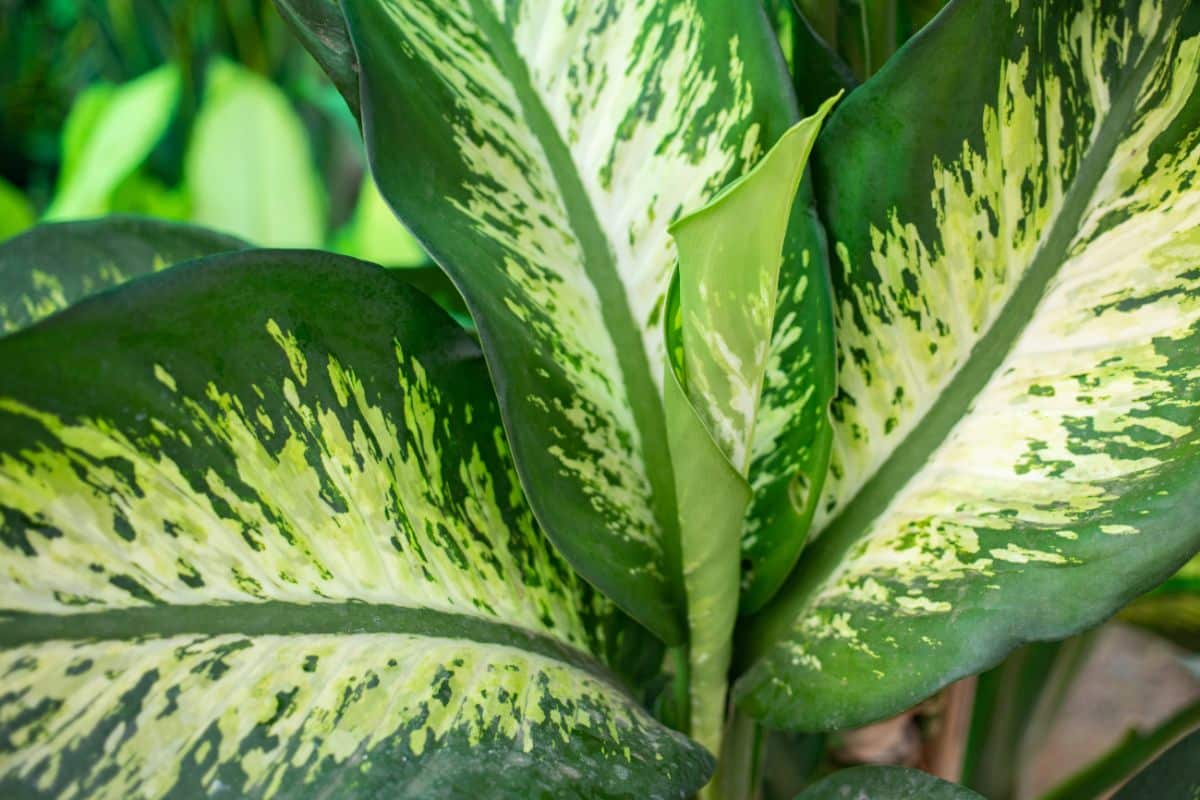
| Plant name: | Dieffenbachia |
| Watering requirements: | Moderate |
| Toxic to pets? | Yes |
| Size: | 3 to 6’ high |
| Special features: | Highly variegated leaves |
Also known as dumb cane, dieffenbachia is one of the prettiest foliage plants you can find. Highly variegated leaves have more light coloration than many other variegated plants, so they are a great addition if your want to add more brightness to your houseplant collection.
There are lots of different dieffenbachia cultivars to choose from. So, if you want to try out this plant at home look for ‘Camille,’ ‘Carina,’ ‘Camouflage’ or other fun types to add more variety to your grow room.
12. Friendship plant (Pilea involucrata)
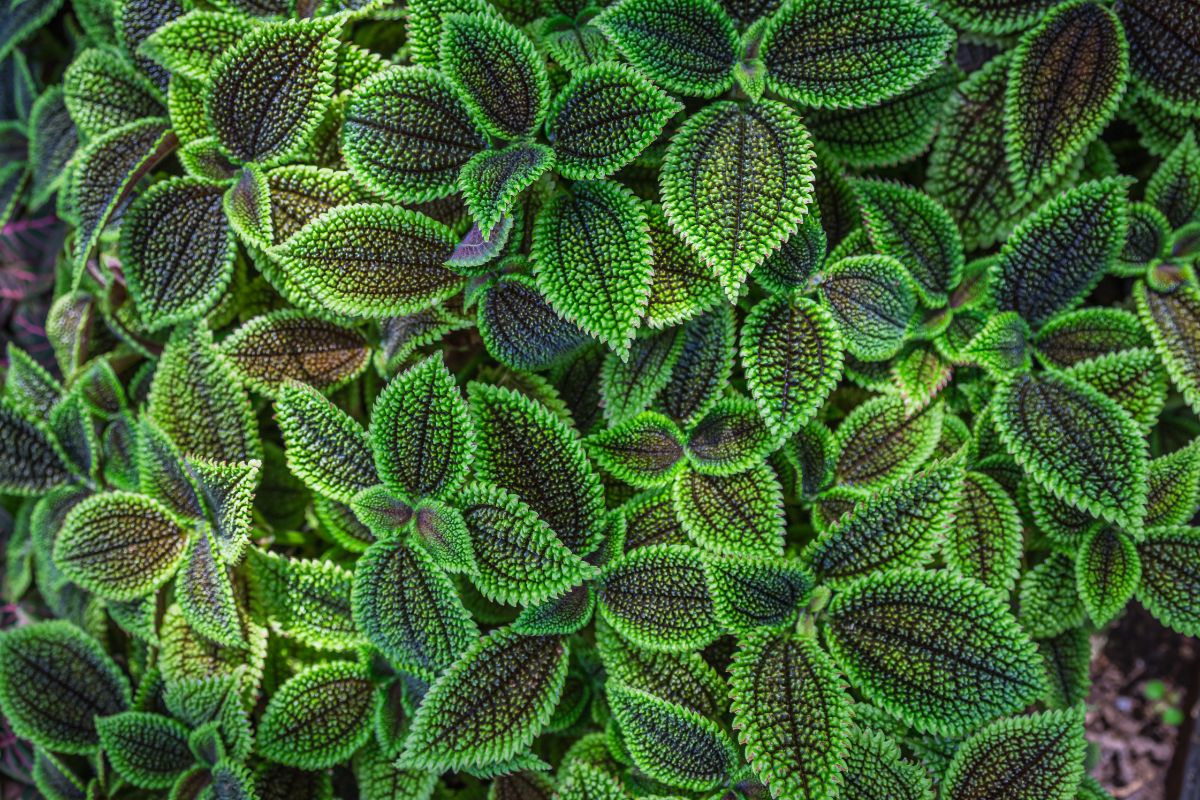
| Plant name: | Friendship plant |
| Watering requirements: | Moderate |
| Toxic to pets? | No |
| Size: | 6 to 12” high |
| Special features: | Highly variegated leaves; great for terrariums |
Native to South and Central America, friendship plant is a bushy, vining houseplant. Two-toned leaves come in a range of colors and featured a highly textured appearance that’s totally unique.
Preferring higher than average humidity levels, friendship plant can be a bit tricky to keep happy. But it does quite well in terrarium setups, which help regulate humidity levels. The plant’s small size also means you won’t need to prune it for terrarium setups either!
13. Monstera (Monstera deliciosa)
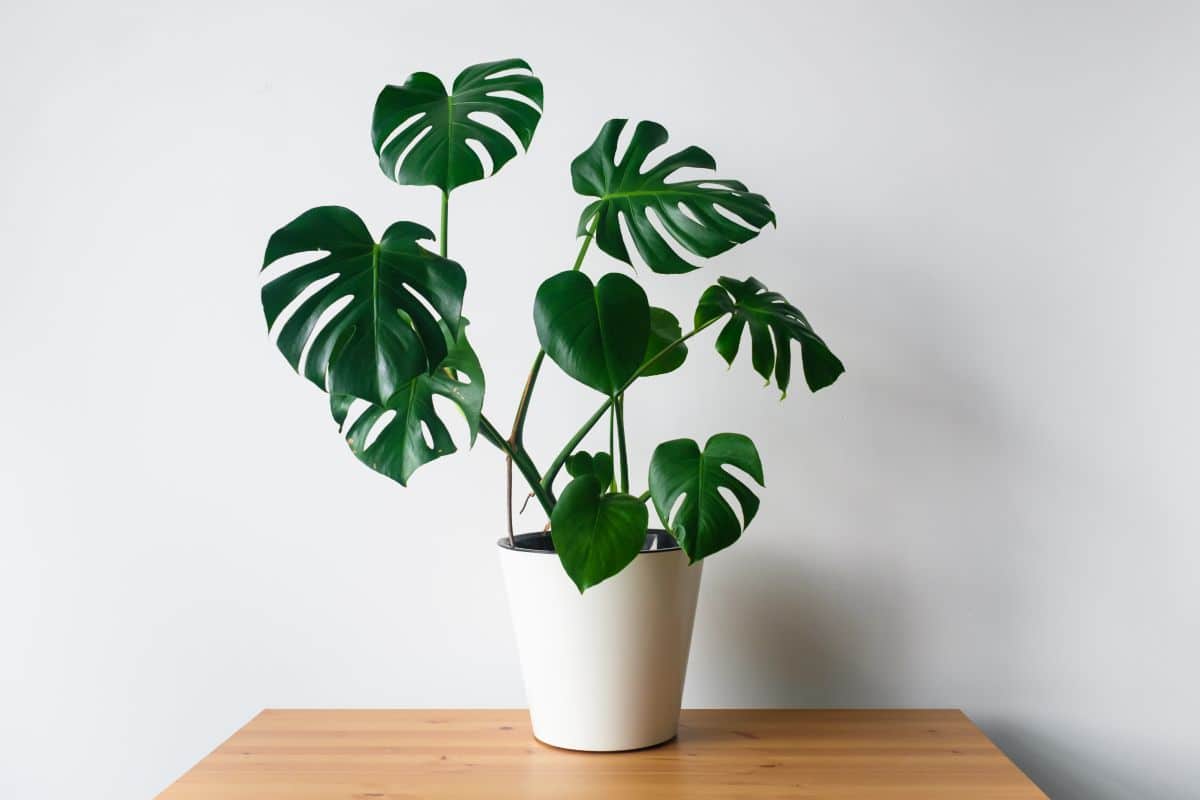
| Plant name: | Monstera |
| Watering requirements: | Moderate |
| Toxic to pets? | Yes |
| Size: | 10 to 15’ high |
| Special features: | Monstera deliciosa produces edible fruit when fully ripe |
One of the most famous houseplants around, monstera leaves have an iconic shape that has been emblazoned on everything from throw pillows to t-shirts. And it’s no wonder why. These stunning plants have highly recognizable, glossy leaves that have a pierced form to them, which has earned them their nickname “Swiss cheese plant.”
Growing quite large, even as an indoor plant, monstera frequently needs a bit of trellising or a few supports to keep it growing tidily. Once mature, plants may also produce edible fruit, but be sure to wait until they are fully ripe to eat them, as unripe fruit can cause throat and mouth irritation and other symptoms.
14. Arrowhead plant (Syngonium podophyllum)
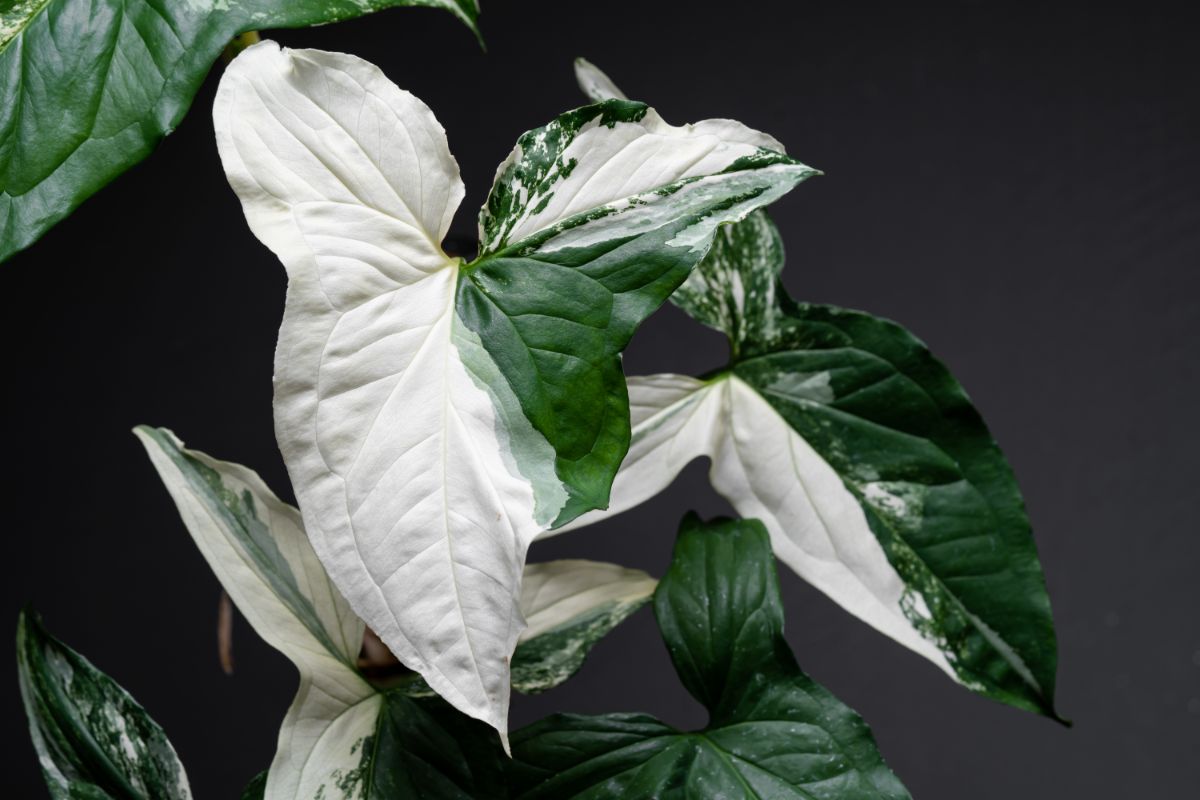
| Plant name: | Arrowhead plant |
| Watering requirements: | Moderate |
| Toxic to pets? | Yes |
| Size: | 3 to 6’ high |
| Special features: | Easily propagated; great for hanging baskets or trellising |
Named for its famously arrow-shaped leaves, arrowhead plants come in a range of colors, including bright green, pink or tan. Leaves often have a marbleized coloration to them as well. An adaptable plant, arrowhead vines can be allowed to drape and vine naturally from their pots, or trained to grow up trellising or supports for a cleaner look.
Easily propagated in water or soil, newly propagated arrowheads sometimes spontaneously create new variegation patterns. So you may find some surprisingly colored leaves on your new baby arrowhead vines!
15. Grape ivy (Cissus rhombifolia)
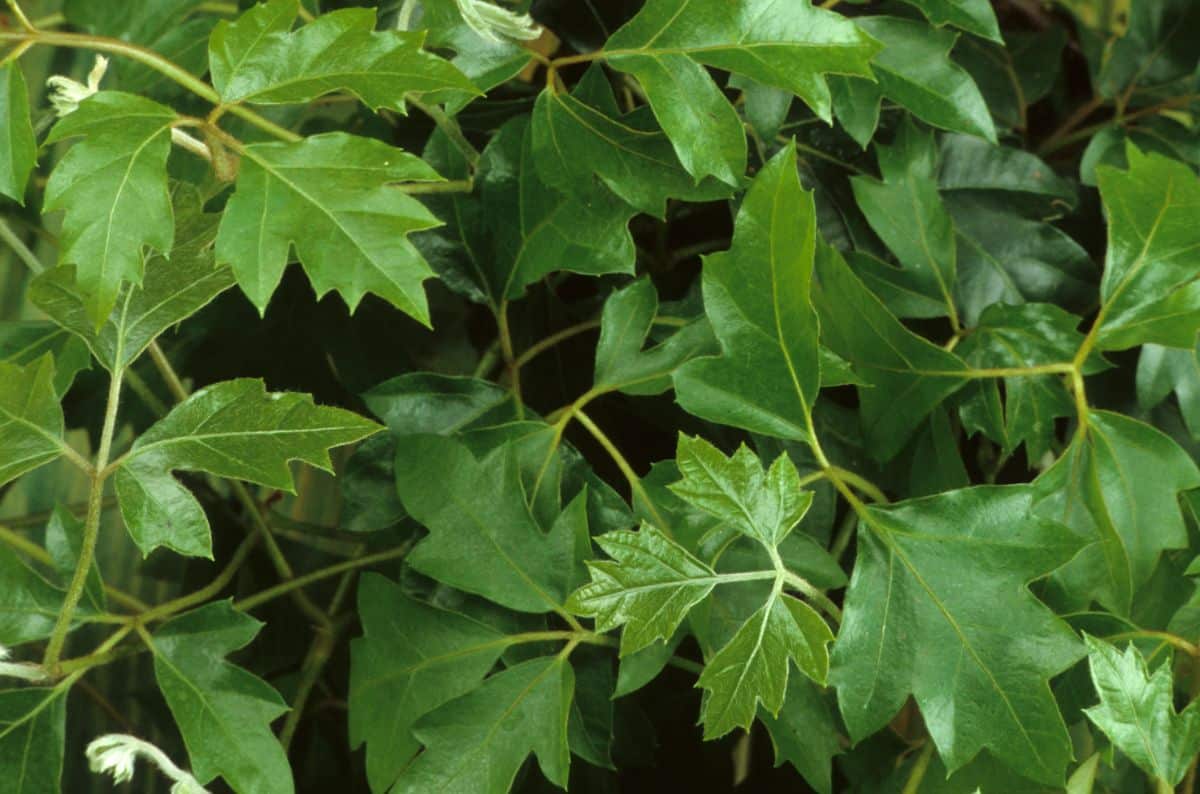
| Plant name: | Grape ivy |
| Watering requirements: | Low |
| Toxic to pets? | No |
| Size: | 6 to 10’ long |
| Special features: | Great for hanging baskets |
Also known as oak leaf ivy, grape ivy is a fun pick. Compared to other vining plants, it has more angular leaves and a slightly glossy appearance that is sure to catch the eye. Draping stems work nicely in hanging baskets, but these plants make attractive tabletop specimens too.
Somewhat prone to root rot, grape ivy doesn’t like waterlogged soil, so only water this plant when the soil is dry to the touch. When watering, allow the water to flow out through the pot’s base and drain away any water that accumulates in the plant’s saucer. You may also want to add a pebble tray under your ivy to increase relative humidity levels.
16. Bird’s nest fern (Asplenium nidus)

| Plant name: | Bird’s nest fern |
| Watering requirements: | High |
| Toxic to pets? | No |
| Size: | 2 to 5’ high |
| Special features: | Good for high humidity spots |
An attractive fern specimen with a bright green color, bird’s nest fern features flat, blade-shaped leaves that have a slight wave to them. This plant looks especially pleasing when potted up in a highly contrasting pot color, like terracotta, that will set off the plant’s vibrant green leaves beautifully.
Like other ferns, bird’s nest ferns prefer high moisture levels and very high humidity. Ideally, you’ll want humidity levels near your fern to be around 75% or higher, so this plant is a perfect choice for humid bathroom spaces.
17. Oyster plant (Tradescantia spathacea)
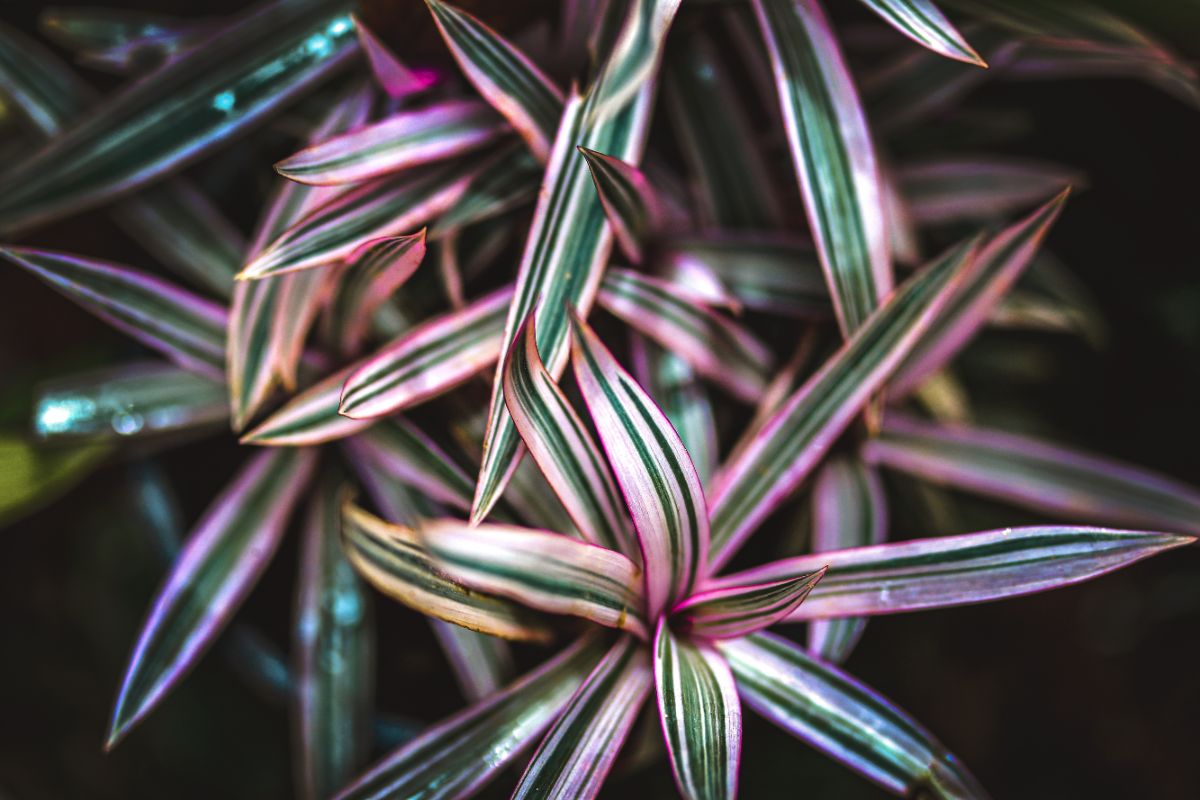
| Plant name: | Oyster plant |
| Watering requirements: | Low |
| Toxic to pets? | Yes |
| Size: | 6 to 12” high |
| Special features: | Colorful leaves |
Also known as Moses-in-the-Cradle, oyster plants are commonly grown as groundcovers in warmer spots, but they make delightful houseplants too. Striped, blade-shaped leaves feature a bright purple coloration in addition to green and white variegation. Brighter light will encourage even richer purple hues.
Easy to grow, oyster plants are closely related to Tradescantia zebrina and have similar care requirements. They also grow quite compactly when kept in pots, so they are a fine pick for smaller spaces and apartments.
18. Prayer plant (Maranta leuconeura)
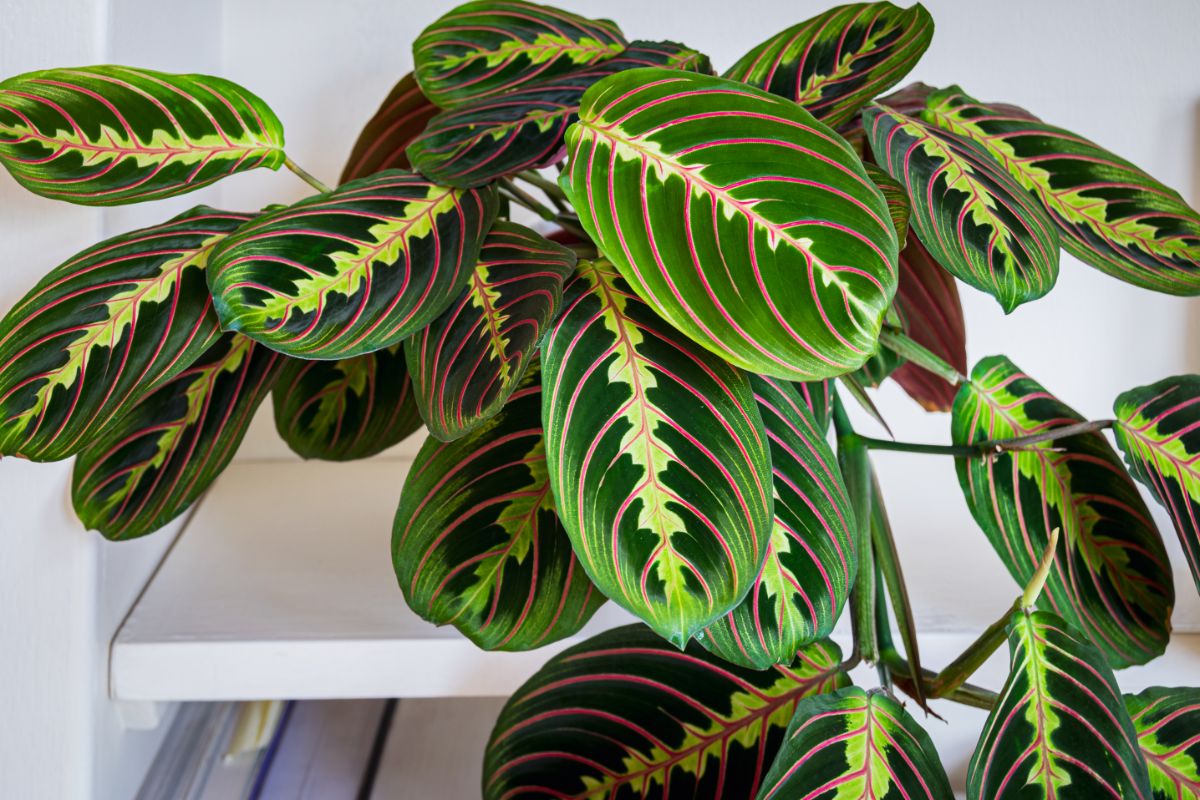
| Plant name: | Prayer plant |
| Watering requirements: | Moderate |
| Toxic to pets? | No |
| Size: | 10 to 12” high |
| Special features: | Colorful leaves move with sunlight |
Prayer plants are known for their distinct, colorful and rounded leaves that boast highly contrasting white, green and red hues. Prayer plant’s leaves move with the sunlight, turning upwards in the evening to help the plant conserve moisture -- a movement that is said to look like hands in prayer.
A simple plant to keep, prayer plants can be pruned for a more compact look or you can allow their trailing stems to drape naturally out of their pot. When properly cared for, prayer plants will also bloom small purple flowers in late spring to early summer.
19. Jade plant (Crassula ovata)
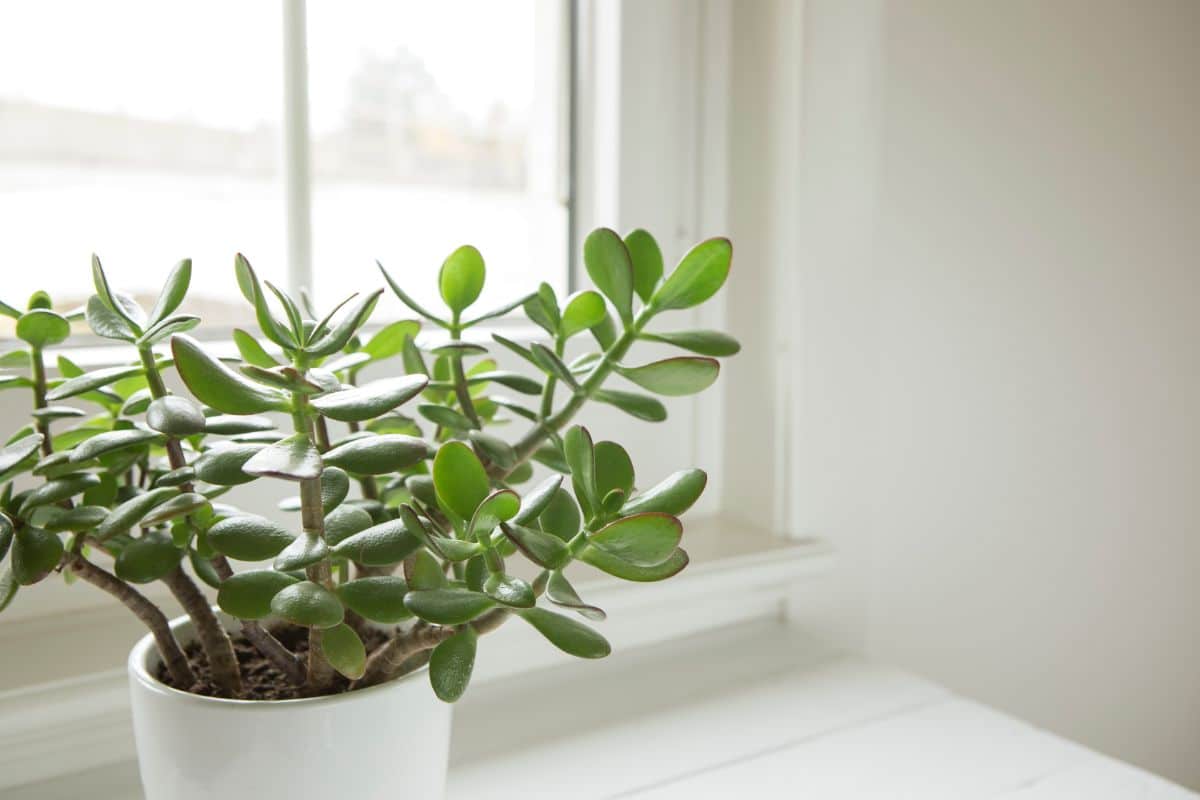
| Plant name: | Jade plant |
| Watering requirements: | Low |
| Toxic to pets? | Yes |
| Size: | Up to 5’ tall |
| Special features: | Tree-like form lends itself well to easy care bonsai |
One of the top choices for succulents, there are just so many reasons to love jade plants. They’re easy to maintain, come in tons of different varieties and some cultivars even look like mini trees as they mature, making them ideal for a low maintenance indoor bonsai.
Like other succulents, jade plants don’t require a lot of water. In fact, stay away from overwatering these plants, as too much water can cause jades to grow top heavy and stems to break under their own weight. Instead, allow the soil to dry out between waterings to keep your jade healthy and thriving for years to come.
20. Rattlesnake plant (Goeppertia insignis)
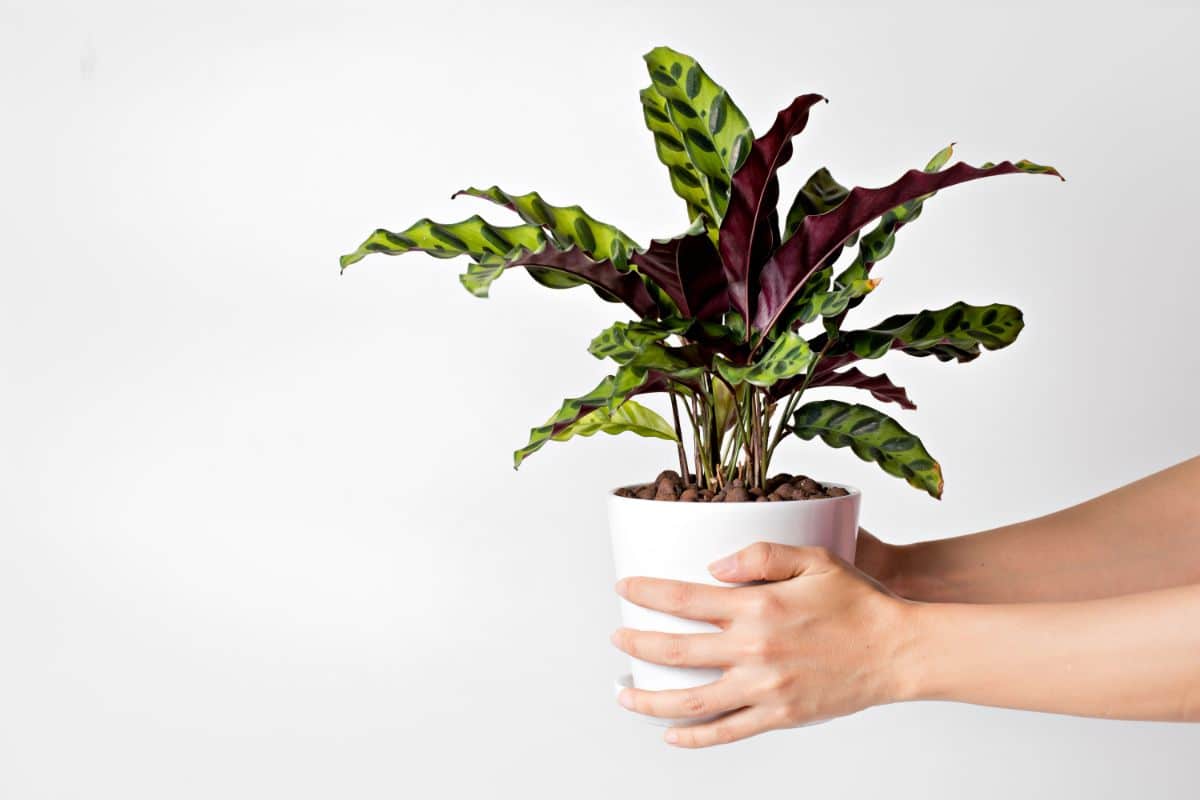
| Plant name: | Rattlesnake plant |
| Watering requirements: | Moderate |
| Toxic to pets? | No |
| Size: | 30’ high |
| Special features: | Highly variegated, colorful leaves |
If you like prayer plants, rattlesnake plants are another must-have plant. With striking, highly patterned leaves with vibrant red undersides, rattlesnake plants are sure to be the stars of your houseplant collection.
Despite their name, rattlesnake plants are non-toxic, so they are a good plant for pet owners. Primarily kept for their foliage, these plants also bloom, but flowers are rare on indoor specimens.
21. Purple passion plant (Gynura aurantiaca)
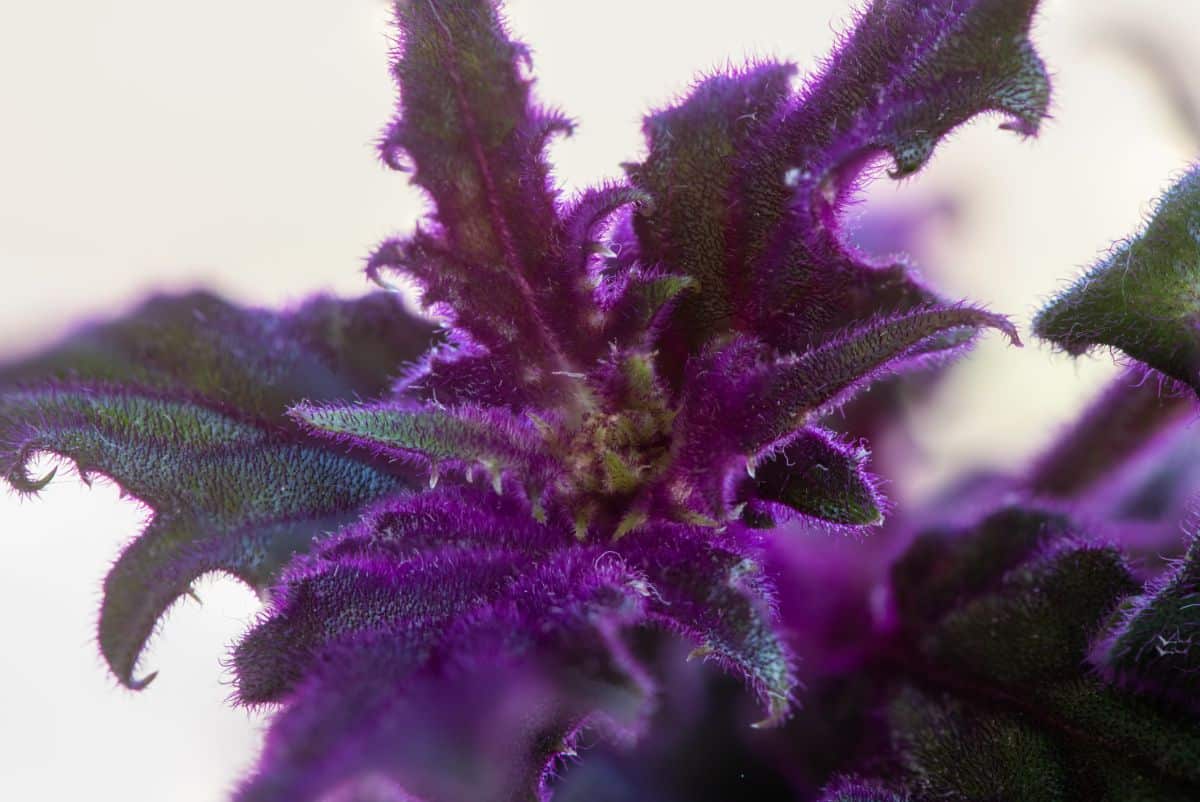
| Plant name: | Purple passion plant |
| Watering requirements: | Moderate |
| Toxic to pets? | No |
| Size: | 1 to 2’ high |
| Special features: | Colorful, furry leaves; orange flowers; works well in hanging baskets |
Also called the velvet plant, purple passion plants are known for their long and jagged leaves that are coated in a soft purple fuzz, giving the plant a bright purple tone. When mature, plants will also bloom a bright orange, dandelion-like flower that contrasts beautifully against the purple leaves.
A naturally trailing plant, purple passion plant can be kept pruned for a more vertical appearance. Cuttings are also easily rooted in soil or water to make more plants. This is important because purple passion plants are short-lived houseplants, but you can keep them going for generations by propagating new plants every few years.
22. Fiddleleaf fig (Ficus lyrata)
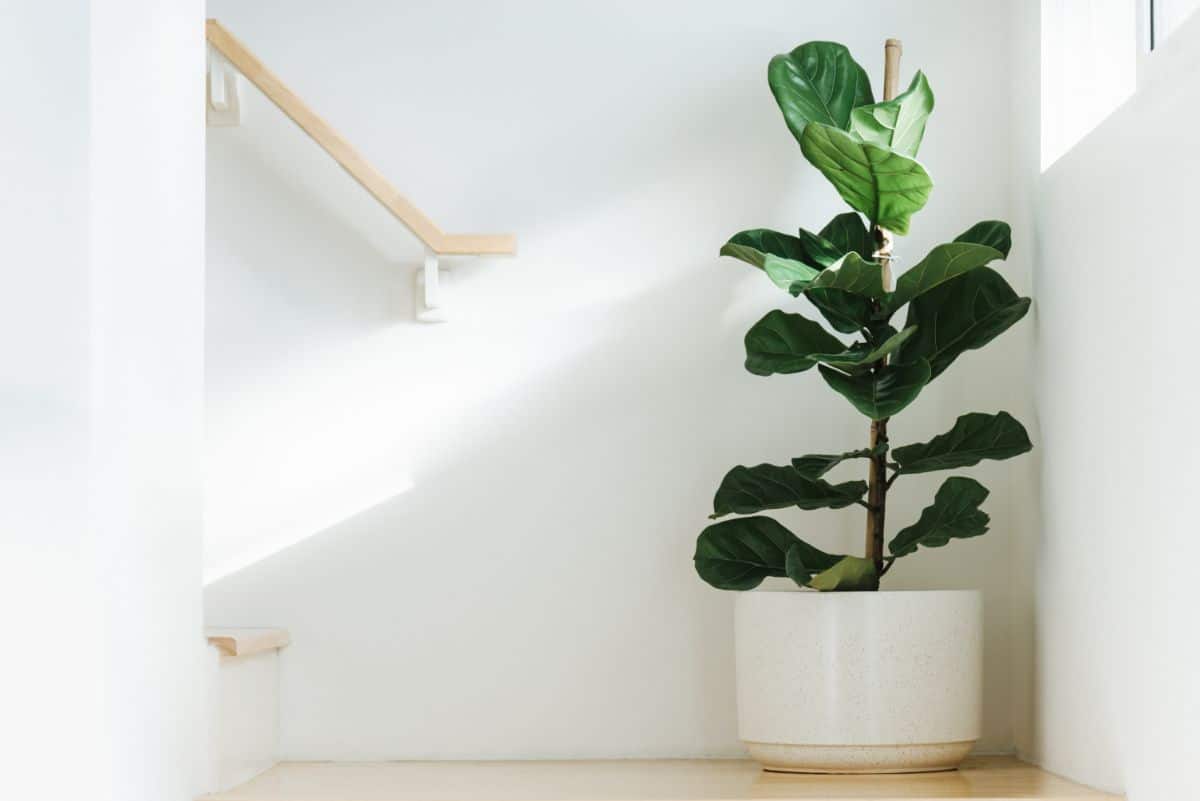
| Plant name: | Fiddleleaf fig |
| Watering requirements: | Moderate |
| Toxic to pets? | Yes |
| Size: | 6’ high |
| Special features: | Mini tree creates lots of visual impact |
One of the largest plants on this list, fiddleleaf fig grows to about 6’ in height, making it a perfect solution for livening up your home. Named for its iconic, fiddle-shaped leaves, fiddleleaf figs are not high maintenance plants, but you do want to be consistent with their watering to avoid unsightly brown spotting on their leaves.
A relative of weeping figs, fiddleleaf figs are less prone to leaf drop when temperatures fluctuate, but you’ll still want to locate your fig away from drafty windows and doors.
23. Money plant (Pilea peperomioides)
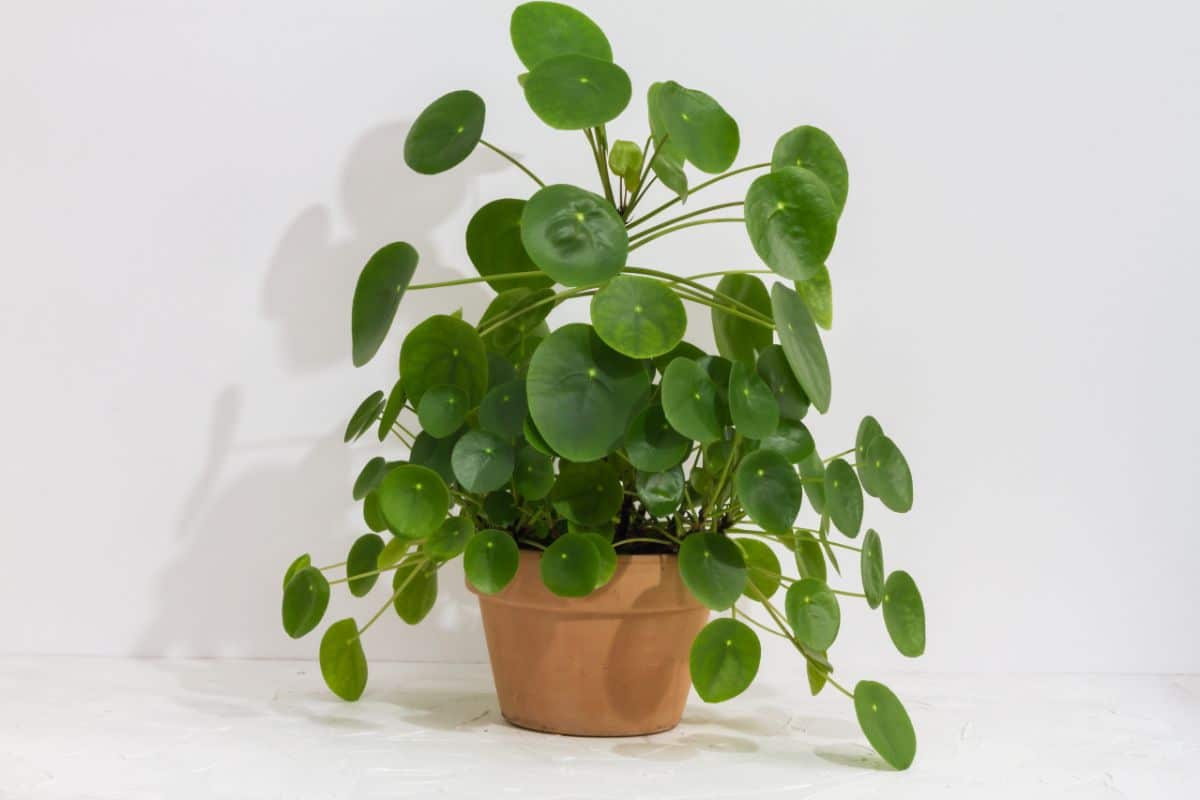
| Plant name: | Money plant |
| Watering requirements: | Moderate |
| Toxic to pets? | No |
| Size: | 12” high |
| Special features: | Propagates easily |
Money plant’s saucer-shaped, glossy leaves are unmistakable and give this plant a very unique look that is guaranteed to make it stand out from any other plants you own. Relatively simple to grow, money plants also easily self-propagate and spread, so they are a perfect pick if you like to share plants with friends.
One of the most popular plants around, money plants are actually related to stinging nettles, but they are perfectly harmless.
24. Rubber plant (Ficus elastica)
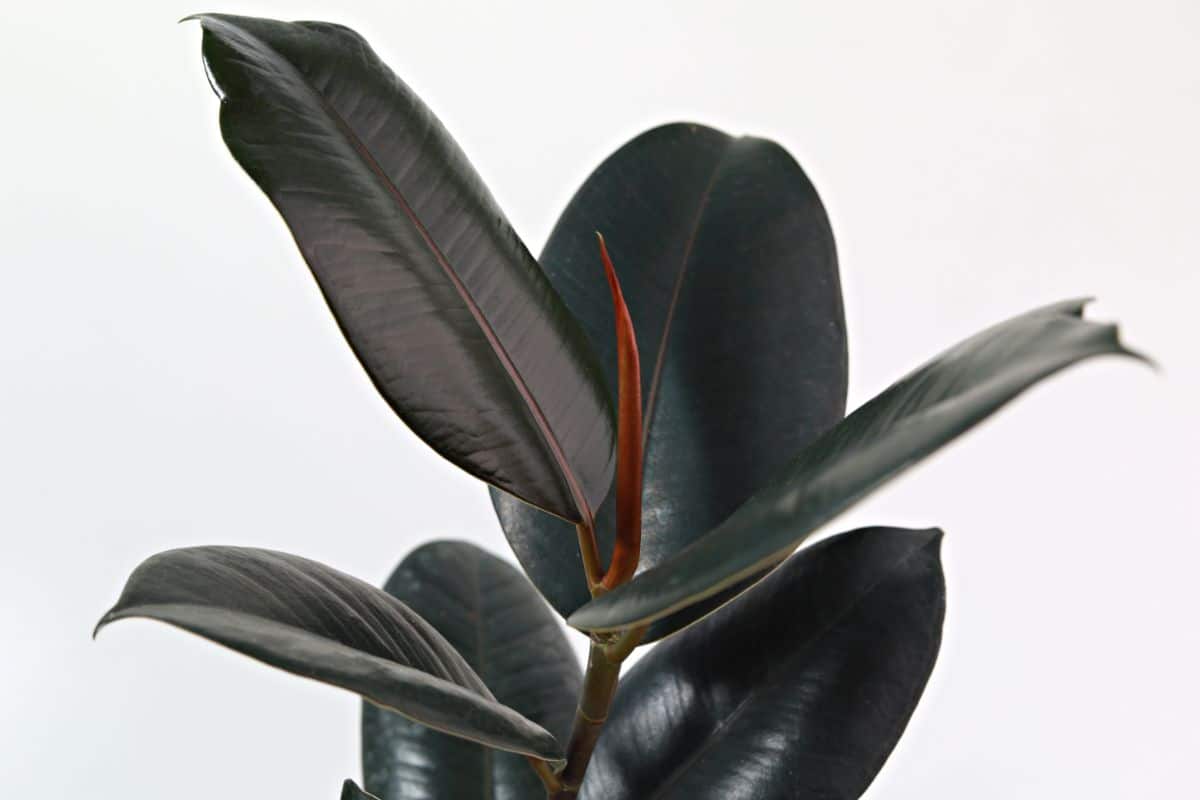
| Plant name: | Rubber plant |
| Watering requirements: | Moderate |
| Toxic to pets? | Yes |
| Size: | 6 to 10’ high |
| Special features: | Mini tree creates lots of visual impact |
Known for the white latex that appears when leaves and stems are damaged, rubber plants were once used to make a natural rubber; however, they are more commonly kept as ornamentals these days. Growing quite massive in nature, rubber plants will stay much smaller when kept in pots.
Glossy, oval leaves are deep, green in color, but when they first emerge from the plant, they are enclosed in a red leaf sheaf, which eventually falls off as the leaf unfurls. A low maintenance plant, rubber plants can adapt to lower light situations, although they prefer bright, indirect light.
25. African violet (Saintpaulia ionantha)
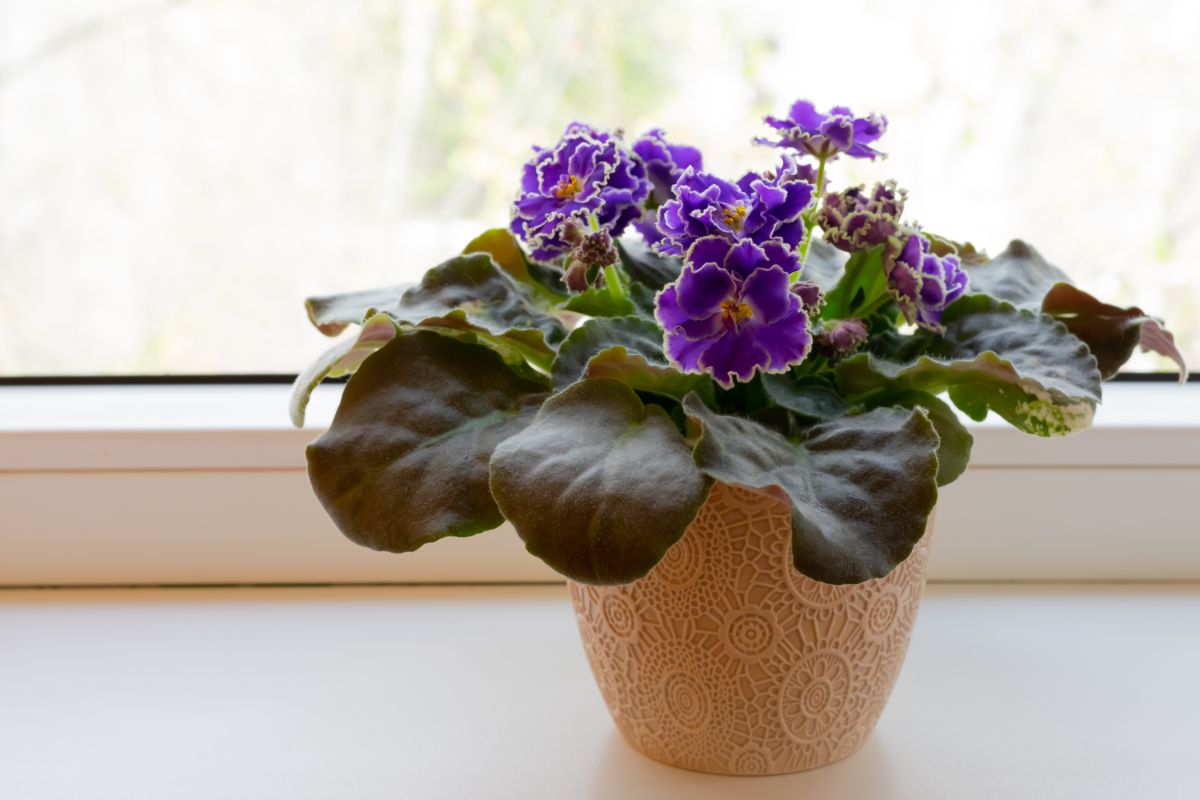
| Plant name: | African violet |
| Watering requirements: | Moderate |
| Toxic to pets? | No |
| Size: | 8 to 16” high (standard sizes), dwarf varieties are smaller |
| Special features: | Long lasting flowers |
A classic pick, every home needs an African violet to brighten up a sunny coffee table or to add a little cheer beside a kitchen sink. These perennial favorites offer round, slightly furry leaves and adorable, colorful flowers in a range of hues, including pink, purple and white. Flowers are often two-toned in color and may feature frilly petals as well.
To keep your African violet happiest, be sure to practice bottom watering as wet leaves can cause damage to your plant. Because of its watering preferences, African violets are often potted up in self-watering planters than keep soil moist, but not soggy.
Frequently asked questions
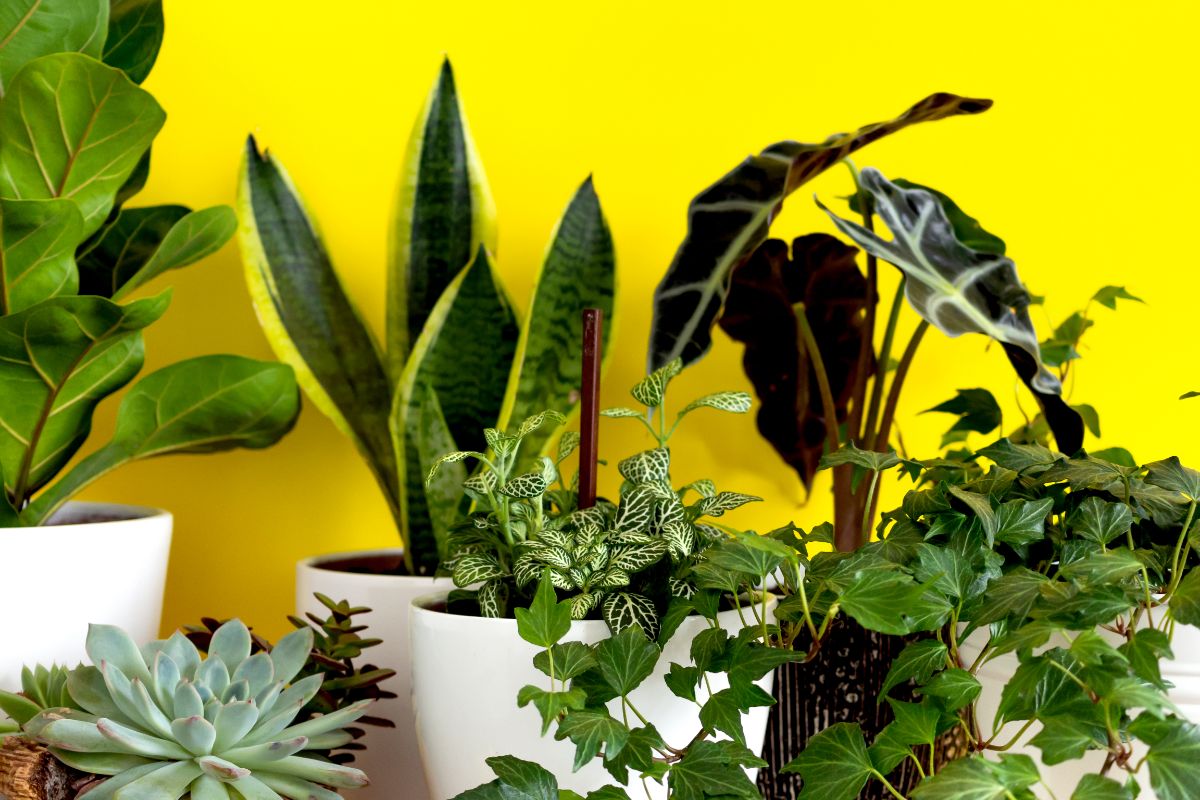
According to a recent study, snake plants were the most Googled houseplant in 2022!
When choosing a new houseplant, be sure to look your plant over carefully for any signs of stress, pests or disease. Check that roots and stems are firm, there are no signs of insects or insect damage on plant leaves and soil doesn’t feel overly soggy.
Plastic pots tend to be hard on houseplants and can promote waterlogged conditions. Most new plants will benefit from being repotted into a more natural container, like terracotta. Be sure to also check water levels and water your new plant if it seems to need it.
Different plants have different watering requirements, but most tropical plants do well with a weekly watering, while succulents and cacti need to be watered much less. A good way to see if a tropical plant needs water is to insert your finger in the soil. If the top 1 to 2” feels dry to the touch, it’s time to water.
Summary
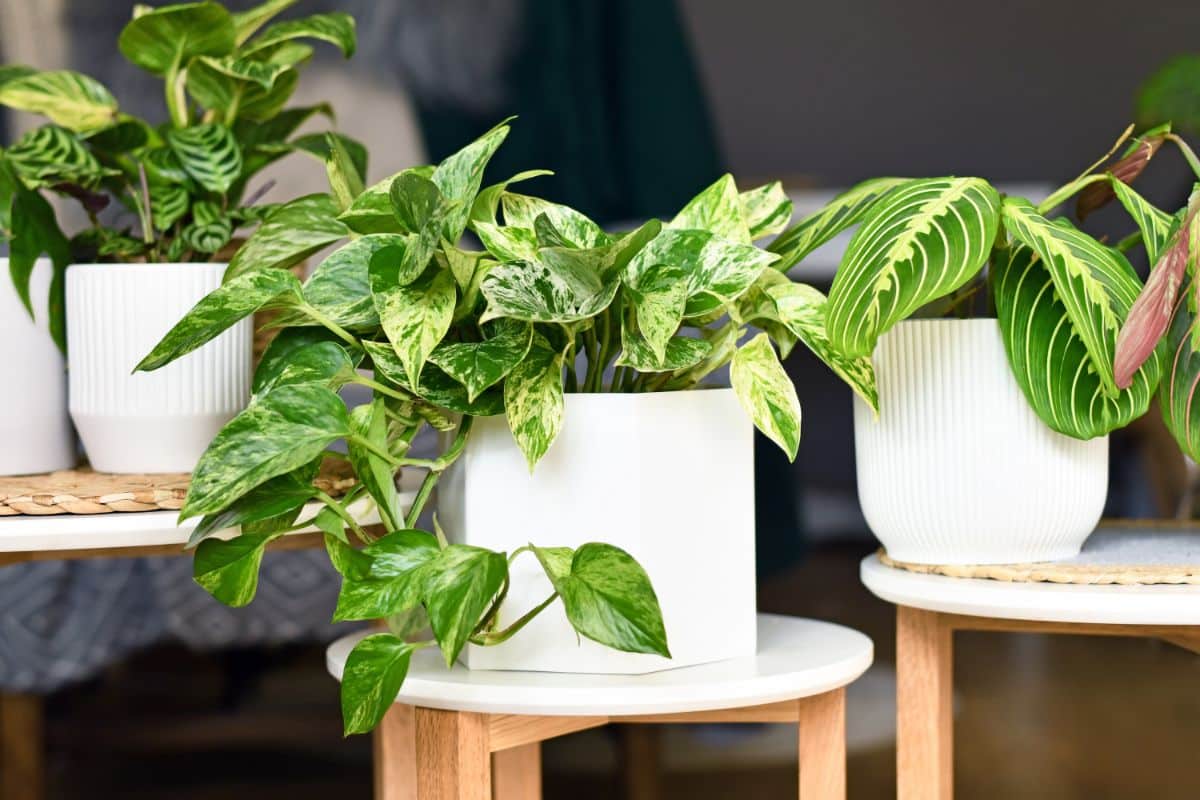
Depending on your plant keeping interests, there are so many different types of popular plants to choose from. From easy care succulents to hanging plants to mini trees for that “wow” factor, adding the right plant to your home can elevate your space and add lots of visual interest.
In this article, we’ve covered some of the most popular houseplants around. But if you’re still on the hunt for the perfect plant for you, check out our guide on non-toxic plants that are great for homes with small children and pets for more easy plants to try!

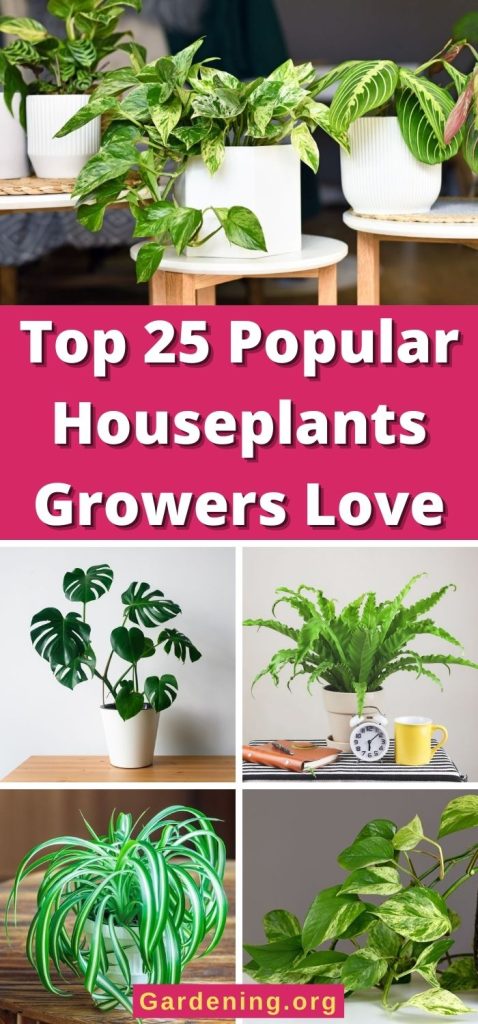
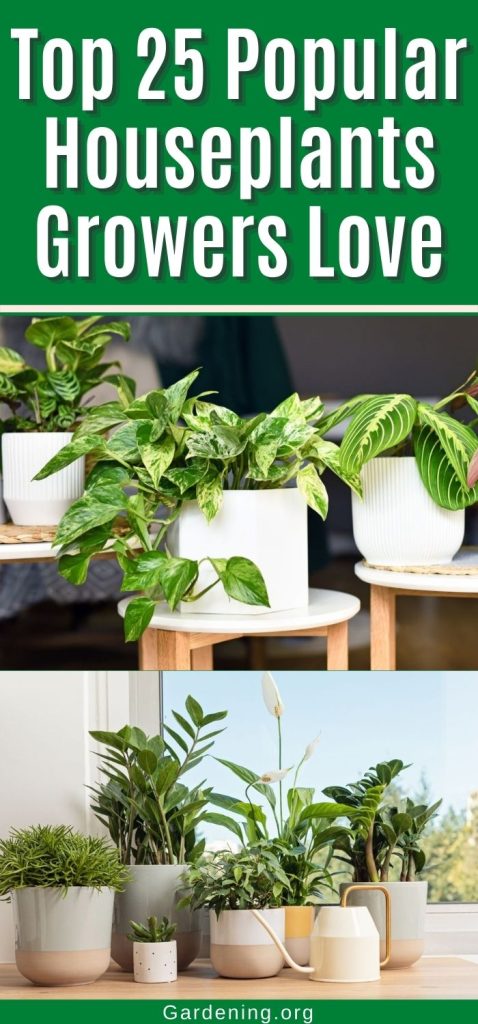
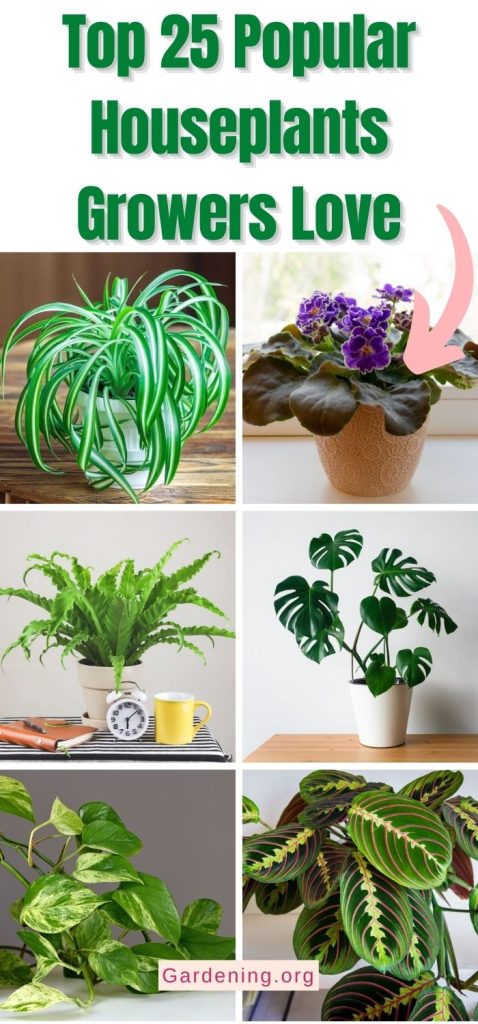
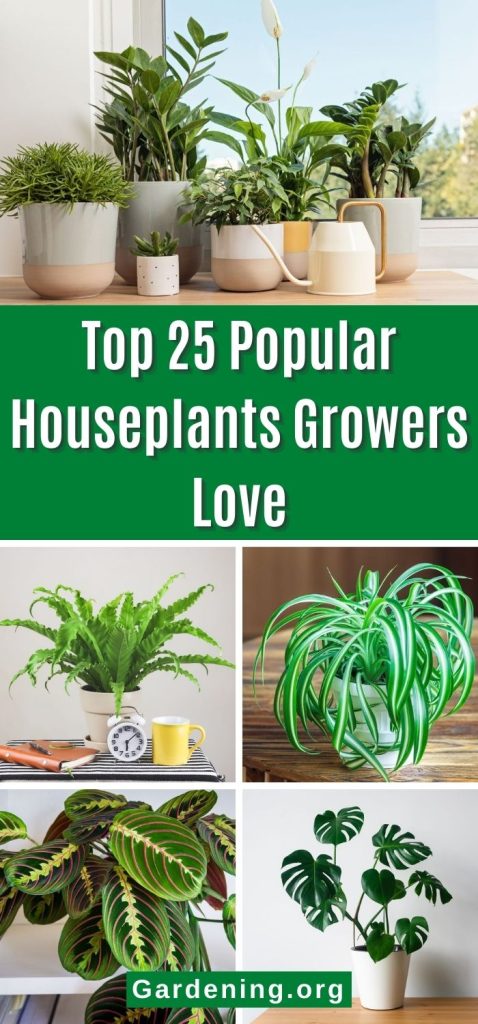
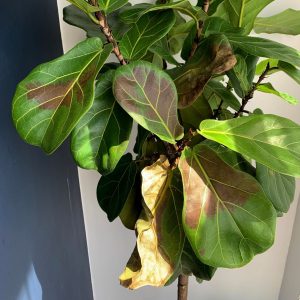
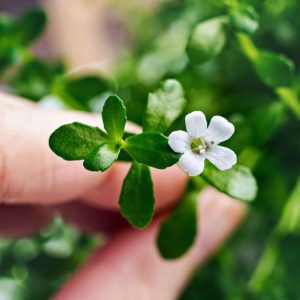
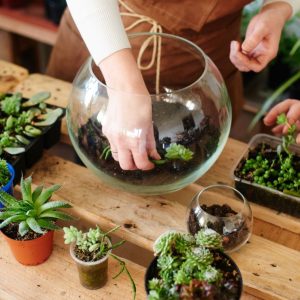
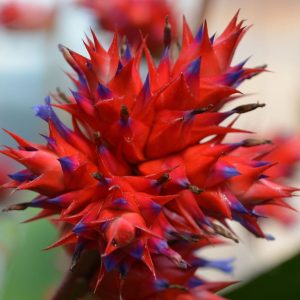
Leave a Reply